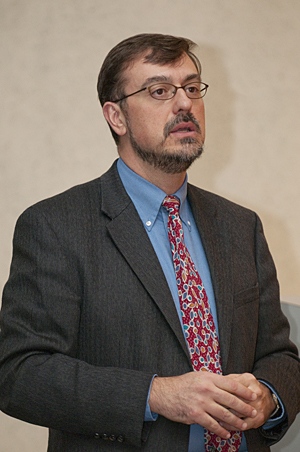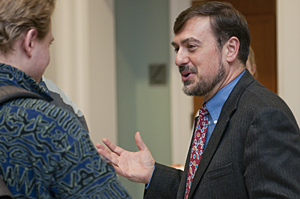
ADVERTISEMENT
- Rozovsky wins prestigious NSF Early Career Award
- UD students meet alumni, experience 'closing bell' at NYSE
- Newark Police seek assistance in identifying suspects in robbery
- Rivlin says bipartisan budget action, stronger budget rules key to reversing debt
- Stink bugs shouldn't pose problem until late summer
- Gao to honor Placido Domingo in Washington performance
- Adopt-A-Highway project keeps Lewes road clean
- WVUD's Radiothon fundraiser runs April 1-10
- W.D. Snodgrass Symposium to honor Pulitzer winner
- New guide helps cancer patients manage symptoms
- UD in the News, March 25, 2011
- For the Record, March 25, 2011
- Public opinion expert discusses world views of U.S. in Global Agenda series
- Congressional delegation, dean laud Center for Community Research and Service program
- Center for Political Communication sets symposium on politics, entertainment
- Students work to raise funds, awareness of domestic violence
- Equestrian team wins regional championship in Western riding
- Markell, Harker stress importance of agriculture to Delaware's economy
- Carol A. Ammon MBA Case Competition winners announced
- Prof presents blood-clotting studies at Gordon Research Conference
- Sexual Assault Awareness Month events, programs announced
- Stay connected with Sea Grant, CEOE e-newsletter
- A message to UD regarding the tragedy in Japan
- More News >>
- March 31-May 14: REP stages Neil Simon's 'The Good Doctor'
- April 2: Newark plans annual 'wine and dine'
- April 5: Expert perspective on U.S. health care
- April 5: Comedian Ace Guillen to visit Scrounge
- April 6, May 4: School of Nursing sponsors research lecture series
- April 6-May 4: Confucius Institute presents Chinese Film Series on Wednesdays
- April 6: IPCC's Pachauri to discuss sustainable development in DENIN Dialogue Series
- April 7: 'WVUDstock' radiothon concert announced
- April 8: English Language Institute presents 'Arts in Translation'
- April 9: Green and Healthy Living Expo planned at The Bob
- April 9: Center for Political Communication to host Onion editor
- April 10: Alumni Easter Egg-stravaganza planned
- April 11: CDS session to focus on visual assistive technologies
- April 12: T.J. Stiles to speak at UDLA annual dinner
- April 15, 16: Annual UD push lawnmower tune-up scheduled
- April 15, 16: Master Players series presents iMusic 4, China Magpie
- April 15, 16: Delaware Symphony, UD chorus to perform Mahler work
- April 18: Former NFL Coach Bill Cowher featured in UD Speaks
- April 21-24: Sesame Street Live brings Elmo and friends to The Bob
- April 30: Save the date for Ag Day 2011 at UD
- April 30: Symposium to consider 'Frontiers at the Chemistry-Biology Interface'
- April 30-May 1: Relay for Life set at Delaware Field House
- May 4: Delaware Membrane Protein Symposium announced
- May 5: Northwestern University's Leon Keer to deliver Kerr lecture
- May 7: Women's volleyball team to host second annual Spring Fling
- Through May 3: SPPA announces speakers for 10th annual lecture series
- Through May 4: Global Agenda sees U.S. through others' eyes; World Bank president to speak
- Through May 4: 'Research on Race, Ethnicity, Culture' topic of series
- Through May 9: Black American Studies announces lecture series
- Through May 11: 'Challenges in Jewish Culture' lecture series announced
- Through May 11: Area Studies research featured in speaker series
- Through June 5: 'Andy Warhol: Behind the Camera' on view in Old College Gallery
- Through July 15: 'Bodyscapes' on view at Mechanical Hall Gallery
- More What's Happening >>
- UD calendar >>
- Middle States evaluation team on campus April 5
- Phipps named HR Liaison of the Quarter
- Senior wins iPad for participating in assessment study
- April 19: Procurement Services schedules information sessions
- UD Bookstore announces spring break hours
- HealthyU Wellness Program encourages employees to 'Step into Spring'
- April 8-29: Faculty roundtable series considers student engagement
- GRE is changing; learn more at April 15 info session
- April 30: UD Evening with Blue Rocks set for employees
- Morris Library to be open 24/7 during final exams
- More Campus FYI >>
3:37 p.m., Dec. 10, 2009----Dion Vlachos delivered his inaugural lecture as Elizabeth Inez Kelley Professor of Chemical Engineering at the University of Delaware on Tuesday, Dec. 8.
“Living in a Multiscale World” described his work in multiscale modeling and simulation, an emerging multidisciplinary scientific field that enables prediction of material properties and processing behavior while reducing computational requirements.
“Everything in our world is multiscale,” Vlachos said. “We just have to decide what we want to focus on.”
He cited the example of a hike through the woods. The experience can be enjoyed at the “macro” level as just an enjoyable walk in a beautiful place. Increasingly smaller-scale views would take in a tree as a whole entity, just the structure of the bark, the molecular composition of the bark, and so on.
In science and engineering, a broad range of problems involve multiple scales, and simultaneously considering all of the variables in all of the scales is prohibitively costly in terms of computing power and time.
Vlachos cited as an example a laundry list of variables to be considered in screening catalysts -- kinetics, adsorbate-adsorbate interactions, catalyst size and shape, molecular architecture, stability, etc. “This list could be two pages long by next year,” he said. “There are too many parameters, and we need a simple framework to study the problem.”
A hierarchy enables rapid screening of chemicals, fuels, catalysts, and other materials. “A high-throughput multiscale-model-based system for design identifies key parameters and eliminates those that don't really matter,” Vlachos explained. “What we're doing is building a catalyst informatics, so that we can do reverse engineering -- we can decide what specific effect we want and then determine which catalyst is the best one for the application.”
“The capability to predict the properties and behavior of novel catalytic materials brings unparalleled opportunities in terms of energy, environmental, and economic impact,” Vlachos added. He admitted that although progress has been made toward this goal, there are enough unresolved issues to keep him and his colleagues busy for at least another decade.
While developments in multiscale modeling have been disseminated through journal papers, workshops, and short courses, Vlachos said that incorporating the knowledge into textbooks is critical in educating students.
In the question and answer session following his lecture, Vlachos was asked about his view of the perfect balance between theory and experiment.
“Experiments and simulations are both important, but the approach needs to be problem driven,” he said. “I find that the most skillful students can do both theoretical and experimental work, but it's true that some do one better than the other.”
“I'm experimenting with that,” he added.
Vlachos, who earned his doctorate at the University of Minnesota, joined the UD faculty in 2000 and was named director of the Center for Catalytic Science and Technology in 2008. He is also director of UD's Catalytic Center for Energy Innovation, funded by the Department of Energy in 2009 through its Energy Frontiers Research Centers program.
Vlachos is an internationally recognized leader in the field of multiscale modeling of complex processes, including energy conversion, film growth, nucleation, and biological systems.
The named professorship honors Elizabeth Inez Kelley, who attended the Delaware Women's College and later graduated from Drexel Institute of Technology. For many years, she served as assistant and private secretary to the President of Merck Chemical Company.
Article by Diane Kukich
Photos by Evan Krape



